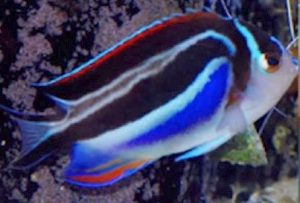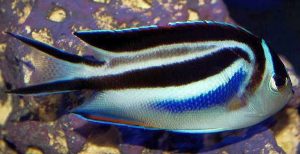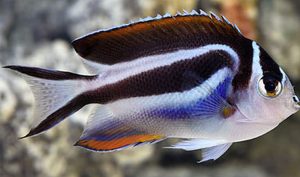The Bellus Angelfish (Genicanthus bellus) known to tropical fish keeping enthusiasts as the Ornate Angelfish is found at depths of 300 feet in the Western Pacific and Indian Oceans, as well as the Phillipine Island chain as far east as Tonga.
Although the Bellus Angelfish is not considered a dwarf angel, it is one of the smaller species of angelfish.
Genicanthus bellus are one of the few sexually dimorphic species of angelfish.
Males and females both have long tapered “swallowtail” like tails that taper into the body.
Males have a predominantly gray colored body with orange dorsal fins and an orange to yellow stripe running along the lateral line. The dorsal, ventral, and top and bottom of the caudal fin is edged in purple and blue, with baby blue and black features on the face and lips.
Female Bellus Angelfish are blue, black, and white to gray with horizontal black, white, and blue lines along the body that transition into vertical
stripes at the head. The dorsal and ventral fins are black; edged in blue, and red to orange depending on the locale where they are collected.
Like many angelfish species, Bellus Angelfish are hermaphroditic and are able to change their sex from female to male. Males will often change back into a female when no females are present in the tank.
The Bellus Angelfish is a peaceful deep water species that is rather difficult to maintain in an aquarium environment. They are best housed in an aged, dimly lit, deep water reef aquarium of at least 70 gallon capacity for a single specimen; or 125 gallon capacity for a pair or group. They require a large amount of live rock in the tank arranged into overhangs and caves for them to hide amongst when they feel threatened and a moderate amount of water flow.
Although a single male can be housed with a harem of several females in a large aquarium; it is best not to keep more than one male in the system. Genicanthus bellus are reef safe and can be maintained with corals, Tridacna clams, and most inverts. Some suitable tankmates include blennies, gobies, Chromis, clownfish, butterflyfish, eels, and small lionfish. Ornate Angelfish are generally peaceful, but it is not a good idea to keep them with angelfish of the genus Genicanthus.
Acclimating this species can be aided by initially keeping the aquarium dimly lit, and then gradually increasing the lighting to normal over a period of several days.
Genicanthus bellus are open water egg scatterers that are difficult to successfully breed in an aquarium environment. Although several tropical fish keeping enthusiasts have seen Bellus Angelfish regularly spawning in very large aquariums, rearing the larvae has been extremely difficult. To date, no successful rearing of larvae have been reported.
In their natural environment, Bellus Angelfish are omnivores that feed primarily on zooplankton and marine algae. In an aquarium environment, they require large amounts of aged live rock to graze upon along with regular feedings of live or frozen Mysis, brine shrimp, shellfish, dried algae, Spurilina, and other greens. A varied diet with several feedings daily will help keep them healthy.
The Bellus Angelfish (Genicanthus bellus) is not common in the aquarium hobby however tropical fish keeping enthusiasts can get them from specialty fish shops and online from auction sites, importers, and several retailers. Because they are collected in deep water environments, they always demand a hefty price when available.
Minimum Tank Size: 70 gallons for one; 125 gallons for groups
Aquarium Type: Deepwater Reef
Care Level: Difficult
Temperament: Peaceful
Aquarium Hardiness: Hardy when acclimated
Water Conditions: 72 – 79°F, dKH 8 to 12 , pH 8.1 – 8.4, sg 1.020-1.025
Max. Size: 7″
Color Form: Black, Blue, White, Yellow
Diet: Omnivore
Compatibility: Reef safe
Origin: Indonesia
Family: Pomacanthidae
Lifespan: 10 years
Aquarist Experience Level: Expert





